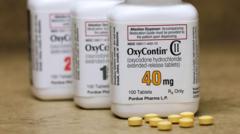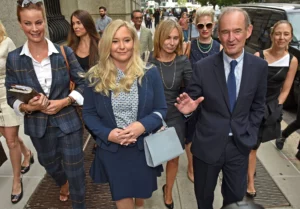The Purdue Pharma and Sackler family, who have faced intense scrutiny over their role in the opioid epidemic, have agreed to a settlement valued at $7.4 billion. This decision marks a significant increase from a previously rejected settlement, highlighting the ongoing efforts to address the devastating impact of opioid addiction in the United States.
Purdue Pharma and Sackler Family Reach $7.4 Billion Settlement in Opioid Crisis

Purdue Pharma and Sackler Family Reach $7.4 Billion Settlement in Opioid Crisis
Purdue Pharma and the Sackler family have struck a historic agreement to pay $7.4 billion to settle claims arising from the opioid crisis linked to OxyContin.
The settlement is designed to aid in the treatment and prevention of opioid addiction and provide relief to those affected by the crisis. However, it still requires court approval to proceed, leaving some critical details pending.
Purdue Pharma will contribute $900 million while the Sacklers will pay up to $6.5 billion. This revised agreement comes after a previous plan was thrown out by the U.S. Supreme Court in 2024, which aimed to give the Sacklers immunity from lawsuits for a smaller payment of $6 billion. Connecticut Attorney General William Tong remarked on the deal's importance, stating: "It's not just about the money. There is not enough money in the world to make it right."
The opioid crisis, exacerbated by Purdue’s aggressive promotion of OxyContin as a safe painkiller while knowing its addictive potential, has led to a dramatic rise in overdose deaths since the late 1990s. The New York Attorney General's office expressed optimism about how this settlement could help fund addiction treatment and preventive measures nationwide.
Transitioning from the past, Purdue has been adamant in highlighting the life-saving measures funds from the settlement will enable. Kara Trainor, a long-time recovery advocate, captured a sentiment many share about the tragedy of the epidemic, stating that the corporate pursuit of profit came at the severe cost of human lives.
Given the deep-seated challenges and the colossal financial interests at stake, this settlement could serve as a watershed moment for accountability in the pharmaceutical industry as it reckons with its role in the opioid crisis. With the impending expiration of legal protections against lawsuits for Sackler family members, the landscape remains complex and fraught with potential challenges. The future course of action will depend heavily on the continued legal negotiations and public response to the agreement.
Purdue Pharma will contribute $900 million while the Sacklers will pay up to $6.5 billion. This revised agreement comes after a previous plan was thrown out by the U.S. Supreme Court in 2024, which aimed to give the Sacklers immunity from lawsuits for a smaller payment of $6 billion. Connecticut Attorney General William Tong remarked on the deal's importance, stating: "It's not just about the money. There is not enough money in the world to make it right."
The opioid crisis, exacerbated by Purdue’s aggressive promotion of OxyContin as a safe painkiller while knowing its addictive potential, has led to a dramatic rise in overdose deaths since the late 1990s. The New York Attorney General's office expressed optimism about how this settlement could help fund addiction treatment and preventive measures nationwide.
Transitioning from the past, Purdue has been adamant in highlighting the life-saving measures funds from the settlement will enable. Kara Trainor, a long-time recovery advocate, captured a sentiment many share about the tragedy of the epidemic, stating that the corporate pursuit of profit came at the severe cost of human lives.
Given the deep-seated challenges and the colossal financial interests at stake, this settlement could serve as a watershed moment for accountability in the pharmaceutical industry as it reckons with its role in the opioid crisis. With the impending expiration of legal protections against lawsuits for Sackler family members, the landscape remains complex and fraught with potential challenges. The future course of action will depend heavily on the continued legal negotiations and public response to the agreement.






















